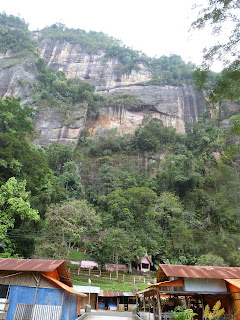As I mentioned in previous posts last week I spent some time up in West Sumatra, which is the center of the Minangkabau culture. The Minang have a language all their own, and although it is very similar to Bahasa Indonesia, there are some differences both in terms of pronunciation and vocabulary. When I was travelling through the region people seemed delighted when I made an attempt to speak the local language, and lots of folks were happy to spend some time to teach me the basics. The problem with learning Minang, though, is that there aren't any texts (that I'm aware of) and internet resources are sadly lacking. What follows is a short guide that should help get you started. People along the way will help you as well.
Personal Pronouns
There are several ways to say "I" in Bahasa Minang. The word you use depends on the status of the person you are talking to.
"Ambo" is a polite term used with people older than you.
"Awak" or "Aden" is used for people that are familiar to you or younger.
Similarly there are several ways to say "you".
Use "Wa'an" for males familiar or younger.
Use "Kau" for females familiar or younger.
Use "Uda" for males older or unfamiliar.
Use "Uni" for females older or unfamiliar.
Use "nyo" or "enyo" for he or she.
One of the simplest transformations is changing "a" at the end of the word to "o". So for instance, lama (long), becomes lamo. Lomba (race) becomes lombo. It doesn't work for "pizza", though. Nobody got the joke when I ordered "pizzo" at the Pizza Hut in Bukit Tinggi. Additionally the pronoun suffix "-nya" becomes "-nyo". For example:
Berapa harganya? (How much is it) becomes "Bara hargonyo".
Another transformation that seems to be quite common is that "ut" at the end of the word in Bahasa Indonesia becomes "ui". For example, "menurut" (according to) becomes "manurui". I'll tell you about why the "e" becomes an "a" in the verb section below.
Counting
The numbers are pretty simple and go like this:
Cieh (1)
Duo (2)
Tigo (3)
Empek (4)
Limo (5)
Enam (6)
Tujuah (7)
Lapan (8)
Sembilan (9)
Sepuluah (10)
Sabale (11)
Duobale (12)
Tigobale (13)
...
Duopuluah (20)
Tigopuluah (30)
...
If you are counting things, you don't use "cieh". Instead you change the Bahasa Indonesia "se" to "sa". Thus "sebungus" becomes "sabunkoi".
Nouns
Remember that "a" becomes "o" at the end of the word. There are also some distinct nouns that don't appear in Bahasa Indonesia.
Ari Hari
Buyuang Boy
Honda motorcycle (any brand)
Kudo horse
Padusi girl
Talua egg
Gale
glass
Oto car
Piti money (duit, uang)
Sarawa pants (celana)
Verbs
In the case of verbs the "e" in the "me-" prefix is generally replaced with an "a". In addition, remember, like nouns, if the word ends in "a" it is generally replaced with "o". So "membeli" (buy) becomes "mambelo". But as in Indonesian conversation, the me- prefix is often dropped. There are some distinct verbs in Minang as well.
Caliak To look, see (lihat)
Karajo To work (kerja)
Lalo To sleep (tidur)
Mangale To sell
Mangecek To talk, speak (berbicara)
Nanyiak To ride (naik)
Patang To come (datang)
Adjectives
Angek hot (temperature)
Gagah handsome (for males)
Rancak beautiful (for girls, scenery, etc)
Lamo slow, long (lama)
Capek fast (cepat)
gadang big (besar)
kete small (kecil)
maha expensive (mahal)
dake close by, near (dekat)
jauwah far away (jauh)
lamak delicious
bana much, very (banyak)
To make a superlative, you use "paling" just like in Bahasa Indonesia, but you change it to "paliang".
Nyo paliang tinggi di siko. He is the tallest here.
Wanting and needing
To say that you want something or you intend to do something you use "ka", which means "to" or "towards".
Aden ka mambail salai baju. I am going to buy a set of clothes.
Aden ka pai. I want to go.
If you want to say that you have to do something, just at "juo" to the end of this construction.
Other Words and Phrases
You will also find the following words and phrases for just getting around and communicating.
Agia Please (as in "please, take one" or "please have a seat")
Alun Not yet (belum)
Ala Already (sudah)
Apo What?
Bilo When (for asking questions)
Sabalum Before (sebelum)
Sakete A bit (sedikit)
Saroman Like (as in comparisons; same as "seperti")
Ala ba bini? Are you married?
Ambo mangecek bahaso Minang. I speak Minang.
Apo karajo uda? What is your job (mister)?
Baa kaba kini? What's up? How are you?
Bilo barangke? When do you depart?
Di ma? Where? (di mana)
Di siko. Here (di sini)
Elo-elo ajo I'm doing fine; I'm okay
Jam bara kini? What time is it?
Lamak Bana Very delicious
Makan bana, kerajo kamale Eating a lot makes one lazy.
Ngak ado piti, ngak ado cinto... If you don't have money, you don't have love.
Onde! My God! Oh! (Aduh!)
Ongok-Ongok Dolam Bocah! Oh woe is me! I am so poor!
Pai ka ma? Where are you going? (Mau ke mana; a greeting)
Rendang saroman raso mancik! This rendang tastes like rat!
If you have any suggestions or corrections, or if you have something you want to say in Bahaso Minang drop me a line. Don't be shy, give it a go. The people will get a kick out of your attempt to speak their language, and you'll meet a lot of interesting folks.



































